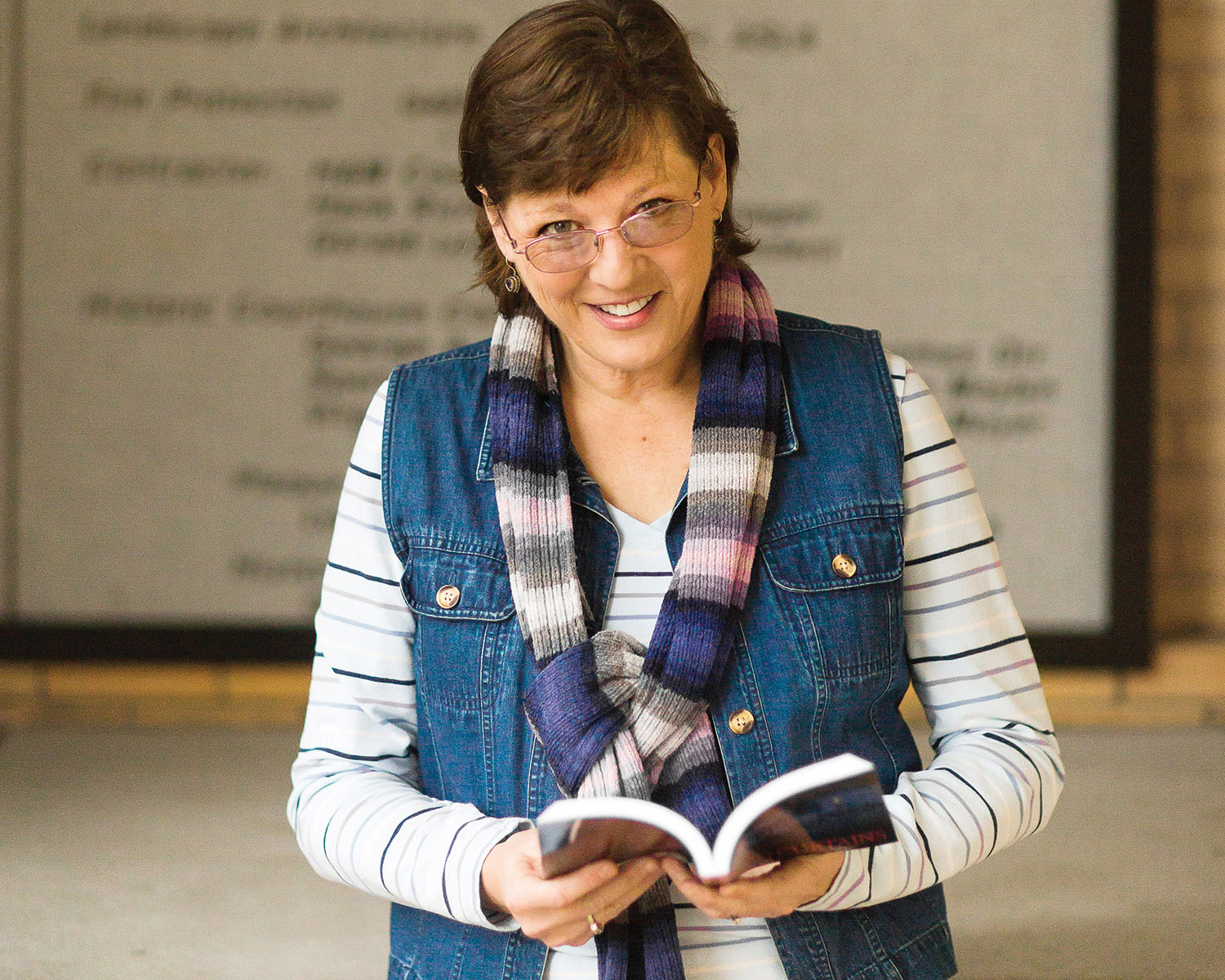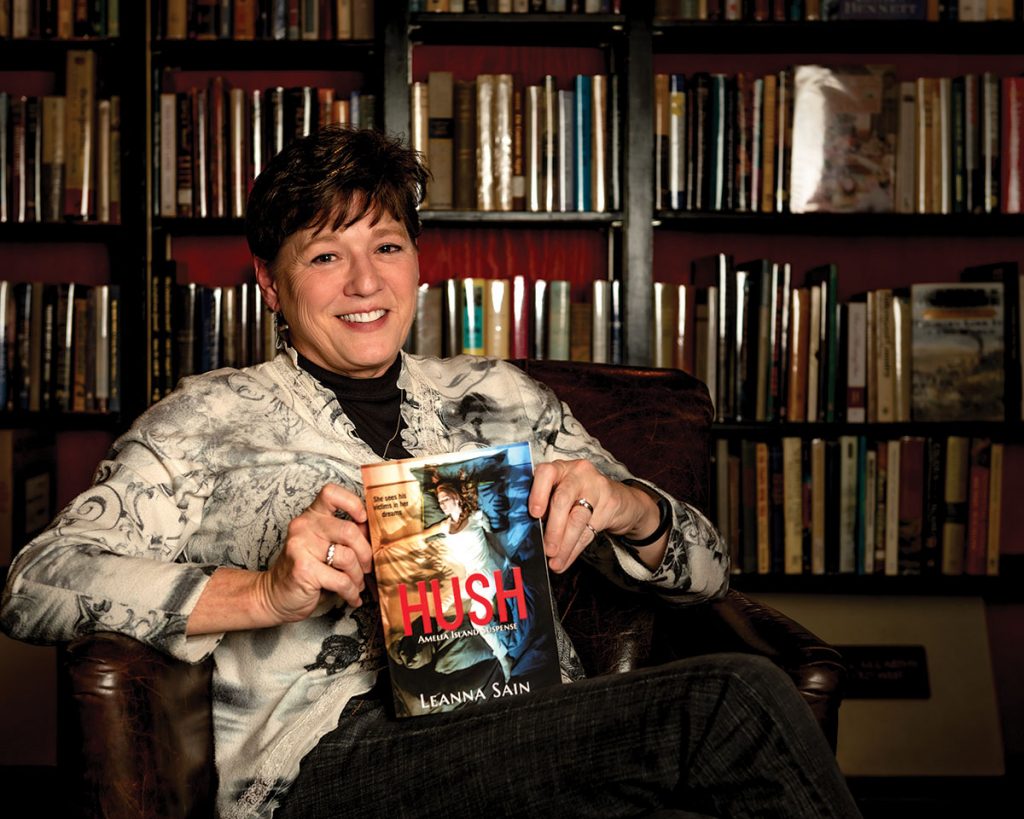
Seen here on a stop in town, Leanna Sain is committed to the homesteading life. She takes inspiration from Tasha Tudor, also a writer, illustrator, and back-to-the-lander. Photo by Tim Robison
The story idea for Leanna Sain’s first romance novel came to her on a holiday typically more gruesome than glamorous: Halloween. The local author was at a party with friends and family when they decided to take a moonlight hike out to an old cemetery. On the walk, her flashlight landed upon a solitary gate, no surrounding fence to be found. In her best horror-movie voice, Sain quipped, “Dun, dun, dun … the gate to nowhere.”
But instead of being spooked, a friend calmly said, “That sounds like the name of a book.” And the rest is history — or, more aptly, historical romantic suspense.
Sain had written as a young child, and later in college, where she pursued a minor in English. “But I never thought there was a novel in there,” she confesses. After that night, though, the cork popped, and a book just started “glugging out.” A seriously busy woman — Sain homeschooled her two sons through twelfth grade while helping run Heartland Amish Furniture (which she co-owns with her husband Randy) — she wrote during her lone bit of free time: in her car, parked under a streetlight, while her oldest boy had football practice.

A discovery on a midnight hike was the catalyst for Leanna Sain’s first book.
At the end of his season, she had a manuscript. She wasn’t sure if it was any good, though, so she enrolled in a novel-writing class at Blue Ridge Community College. She came out of the course with a completed book she felt confident about, and that would soon be published.
The gate in Gate to Nowhere, and the subsequent novels in its trilogy, doesn’t actually lead to oblivion. Instead, it draws readers back to the 19th century, an era Sain has long favored — and whose details she gets just right: two books in the series received the Clark Cox Historical Fiction Award.
Also a commissioned portrait artist, Sain loves the time period partly because of her affection for illustrator Tasha Tudor, who died in 2008 at age 92. The famed children’s-book creator, known for her charmingly intricate renderings of kids and animals in watercolor and pen-and-ink, was a living anachronism. Despite being born into a wealthy family, the eccentric Tudor resided wholly off grid, staying true to early-1800s ideals. She raised Nubian goats, Corgis, and four children in a centuries-old New England farmhouse with no electricity or running water.
Like Tudor, Sain lives the homesteading life, on small Miracle Farm in Henderson County, where she keeps chickens and grows and preserves her own food. She was able to spend time with her idol twice before the illustrator’s death, and both instances happened thanks to loving gestures by her husband. The first time was a birthday gift, a weekend group tour of Tudor’s Vermont home and gardens.
The second was even more unexpected, and even more thoughtful. Tudor didn’t allow visitors to photograph her, but on that tour weekend, Sain desperately wished she could capture her role model’s essence somehow. After returning to North Carolina, Randy repeatedly contacted Tudor’s eldest son Seth, who still runs the estate. Finally Seth agreed to allow Sain a more intimate meeting — and the opportunity to sketch his mother. That illustration now hangs in the Tasha Tudor Museum in Brattleboro.
Although none of Sain’s male characters are based on Randy and his romantic gestures, per se, their union — the couple recently celebrated their 31st anniversary — does play a role in her writing. “Having a happy marriage helps with the [good outcomes] in my stories,” she shares.
She describes her style as “sweetheart romance,” meaning she doesn’t write the kind of books that warrant a Fabio cover — and certainly nothing close to Fifty Shades of Grey territory. Instead, she’s more like Diana Gabaldon, author of the Outlander series (Sain’s fans have noted likenesses between the two writers’ styles).
“I made myself a promise when I first started writing that if I had a teenager daughter, I wouldn’t be embarrassed for her to read my books,” she explains.
The sweet-and-tender angle is just fine with her current publisher, Wild Rose Press, which put out her latest novel, Red Curtains, in September. Set in modern times, it features Cleo, a shy art student at Savannah College of Art and Design who befriends an eccentric homeless woman: the model for her senior project. But in doing so, Cleo unwittingly stumbles upon criminal activity. As a result, she meets the handsome Jonas Holmes, an investigative reporter who wants to know why the bodies of homeless men keep showing up in the nearby river. Romance blooms between them as they work together to solve the apparent murders. But will they uncover the mystery before it’s too late … ?
“There has to be conflict,” Sain notes. “A little edge of danger.”
In the middle of this month, the author will appear at the Amelia Island Book Festival in Fernandina Beach, Florida: a warm fit for Valentine’s Day. But then she’ll come back to the unpredictable winter mountains — home. “I like happily-ever-afters,” she says.
To find out more about Leanna Sain’s work, check out the author’s website: leannasain.com.

